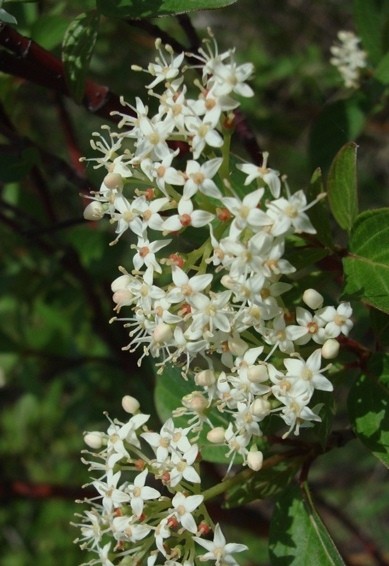Dogwood
(Cornus sericea sericea)

Description
Cornus is a genus of about 30–60 species of woody plants in the family Cornaceae, commonly known as dogwoods, which can generally be distinguished by their blossoms, berries, and distinctive bark. Most are deciduous trees or shrubs, but a few species are nearly herbaceous perennial subshrubs, and a few of the woody species are evergreen. Several species have small heads of inconspicuous flowers surrounded by an involucre of large, typically white petal-like bracts, while others have more open clusters of petal-bearing flowers. The various species of dogwood are native throughout much of temperate and boreal Eurasia and North America, with China, Japan, and the southeastern United States being particularly rich in native species. Species include the common dogwood Cornus sanguinea of Eurasia, the widely cultivated flowering dogwood (Cornus florida) of eastern North America, the Pacific dogwood Cornus nuttallii of western North America, the Kousa dogwood Cornus kousa of eastern Asia, and two low-growing boreal species, the Canadian and Eurasian dwarf cornels (or bunchberries), Cornus canadensis and Cornus suecica respectively. Depending on botanical interpretation, the dogwoods are variously divided into one to nine genera or subgenera; a broadly inclusive genus Cornus is accepted here. The name "dog-tree" entered the English vocabulary before 1548, becoming "dogwood" by 1614. Once the name dogwood was affixed to this kind of tree, it soon acquired a secondary name as the Hound's Tree, while the fruits came to be known as "dogberries" or "houndberries" (the latter a name also for the berries of black nightshade, alluding to Hecate's hounds). Another theory advances the view that "dogwood" was derived from the Old English dagwood (dagwood is a form which is unattested), from the use of the slender stems of its very hard wood for making sharp objects: "dags" (daggers, skewers, and arrows). Another, earlier name of the dogwood in English, is the "whipple-tree". Geoffrey Chaucer uses "whippletree" in The Canterbury Tales ("The Knight's Tale", verse 2065) to refer to the dogwood. A whippletree is also an element of the traction of a horse-drawn cart, linking the drawpole of the cart to the harnesses of the horses in file; these items still bear the name of the tree from which they are commonly carved.
Taxonomic tree:







